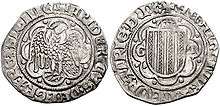Frederick the Simple
Frederick III (or IV) (1 September 1341 – Messina 27 July 1377[1]), called the Simple, was King of Sicily from 1355 to 1377. He was the second son of Peter II of Sicily and Elisabeth of Carinthia. He succeeded his brother Louis. The documents of his era call him the "infante Frederick, ruler of the kingdom of Sicily", without any regnal number.
| Frederick III | |
|---|---|
 A real of Frederick the Simple | |
| King of Sicily | |
| Reign | 16 October 1355 - 27 July 1377 |
| Predecessor | Louis, King of Sicily |
| Successor | Maria, Queen of Sicily |
| Born | 1 September 1341 Catania |
| Died | 27 July 1377 (aged 35) Messina |
| Spouse | Constance of Aragon Antonia of Baux |
| Issue | Maria, Queen of Sicily |
| House | Barcelona |
| Father | Peter II of Sicily |
| Mother | Elizabeth of Carinthia |
"Frederick the Simple" is often confused with an earlier Sicilian monarch, his grandfather Frederick II, who chose to call himself "Frederick III" even though he was actually only the second King Frederick to occupy the Sicilian throne; his self-appellation was retained by later generations of genealogists and historians. The first King Frederick on the Sicilian throne was the latter's great-grandfather, King Frederick II, Holy Roman Emperor.
Frederick III was born in Catania and succeeded to his brother Louis in 1355 under the regency of his sister, Euphemia of Sicily. In his youth the reign was under the control of powerful Sicilian barons, in particular of Artale I Alagona. The beginning of Frederick III's reign was also plagued by intermittent wars with the Kingdom of Naples (see War of the Sicilian Vespers) and also by the Black Death, to which his elder brother and predecessor had succumbed. On 25 December 1369, Frederick ordered all Jews to wear a badge indicating their heritage. The badge consisted of a piece of red material, not smaller than the largest royal seal; men were required to wear it under the chin, and women on the chest. In 1372 he was able to come to peace terms with Naples and Pope Gregory XI, obtaining the title of tributary King of "Trinacria".
After the death of his mother's cousin, Margaret of Tyrol in 1269, Frederick remained the sole descendant of the House of Gorizia-Tyrol which had ruled a vast territory in the Eastern Alps, comprising Tyrol, Carinthia and Carniola. However, due to his problems at home, he is not known to have ever raised any claims to those territories which thus passed to the Habsburgs.
Marriages
On 11 April 1361, Frederick married firstly Constance of Aragon, daughter of King Peter IV of Aragon.[2] They had only one daughter, Maria.[2]
On 17 January 1372, Frederick married secondly Antonia of Baux. This marriage was designed to seal the Treaty of Villeneuve of 1372, by which Frederick's right to rule Sicily was recognised by Naples and the Papacy. There were no children from this marriage. Frederick was betrothed again to Antonia Visconti, but he died before the wedding and was succeeded by his only child, Queen Maria.
References
- Setton, Kenneth M. (1975) "Volume III: The fourteenth and fifteenth centuries", Edited by Harry W. Hazzard, page 214.
- Archbishop Pierre d'Ameil in Naples and the Affair of Aimon III of Geneva (1363-1364), Kenneth M. Setton, Speculum, Vol. 28, No. 4 (Oct., 1953), 645.
| Regnal titles | ||
|---|---|---|
| Preceded by Louis |
King of Sicily 1355–1377 |
Succeeded by Maria |
| Preceded by Frederick I |
Duke of Athens and of Neopatria 1355–1377 | |